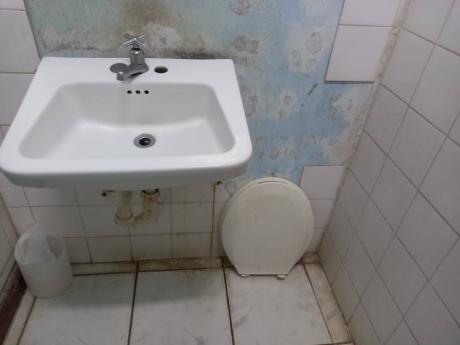Editorial | Decent public toilets a priority
There is a propensity among Jamaican officials to blame an absence of civic mindedness by citizens, and their supposed disregard for hygiene, for the squalor that exists in public spaces and in sections of too many public institutions. The solid waste management people and their governmental bosses tend to refer to people’s so-called ‘nastiness’.
While he did not make a full plunge, Christopher Tufton, the health minister, added a tepid toe to that blame game last week in an attempt to avoid accountability for the vileness of the public restrooms at several hospitals, which was highlighted by this newspaper on Sunday.
The minister acknowledged the Government’s obligation for ensuring that state-run hospitals have clean bathrooms but suggested that public abuse of the facilities was a major cause of the decrepitude and filth reported on by The Sunday Gleaner.
“So you put new facilities in the bathroom – dispensers, toilet papers – and what we have found is that oftentimes, they go missing quickly because patients take those things,” Tufton said.
In other words, toiletries, and, in some cases, hardware, including toilet seats and flapper balls for toilet tanks (taking into account the claims of Errol Greene, CEO of the South East Regional Health Authority) are being stolen by patients and visitors to the institutions.
We have no basis to question that conclusion by Dr Tufton, Mr Greene, or any of the other administrators, who were either ignorant of the state of the facilities or blamed the situation on the behaviour of outsiders.
PUBLIC RELATIONS DISTRACTIONS
We are concerned, though, about the manner in which the hospital bosses appear to be responding to the revelations – seemingly as public relations distractions, rather than a potential public health crisis. Either approach determines a posture that determines their philosophical approach to the fix.
In the former circumstance, it is a matter of rehinging some doors to toilet stalls; buying a few toilet seats and flapper balls; sourcing a few rolls of toilet paper; and, perhaps, placing some deodorants in the restrooms. Get past the immediate embarrassment, until the same problem, or something akin thereto, next makes its way into the public domain.
In embracing the latter approach, the issue is just a matter of cleaning toilets used by the public. For then, it is not separate from the hygiene of the entire health institution. Which makes it a fundamental matter of management.
Put another way, the scandalous state of the public toilets at these public hospitals is not entirely separate and cannot be ring-fenced from the matter of the 13 babies who died from bacterial infections at the Victoria Jubilee Hospital’s maternal ward over the summer, or the 17 who died similarly, mostly at the University Hospital of the West Indies, in 2015.
Fortuitously, in those cases, the deaths were confined to maternity wards. Though late, crisis-response protocols worked in both cases.
However, by their very nature, hospitals and other healthcare institutions are susceptible to, and notorious for, the spread of bacterial infections. Bacteria abound in them.
The bugs are kept at bay from healthy people because healthcare workers – doctors, nurses, and other staff – generally adhere to established protocols for the management of these institutions, the most fundamental of which is hygiene. Cleaning and sanitisation are continuous. Indeed, the deaths of some of the babies in 2015 and this year were due, in part, to a stumble, if not full breakdown, in these regimes.
LIMITED COMFORT
It is only of limited comfort that the poorly maintained and broken, dirty toilets identified by The Sunday Gleaner were not on the wards or in specialised areas of the hospitals, where the contracting and transmission of infections is more likely. For poorly kept public toilets are notorious as places where bacteria linger, with potentially dangerous consequences.
Moreover, many of the people who use the public toilets at hospitals do so both before and after they visit wards. The possibility for taking infections to or from wards via toilets is obvious. Those risks are minimised by cleaning and proper maintenance.
That is why toilets at a healthcare facility, whoever uses them, should be subject to the same, or similar, cleaning protocols as the rest of the institution. Their upkeep, too, must be a priority.
These are among the least-cost elements of public-health management. They are preventative measures that save much – in money, and potentially, in human lives. It is, therefore, better to spend a few dollars more on these measures rather than scrimp on pennies and court danger.
Further, while we agree that Jamaicans should treat public restrooms with respect, that doesn’t remove the responsibility for management to keep them clean and user-friendly. In many countries, restrooms at public facilities are constantly cleaned throughout the day – as a sanitary requirement and as a declaration of the quality of service managers want to deliver to the public. These jobs are usually the cheapest on an organisation’s payroll.
But the approach is part of the philosophy of doing the little things continually and getting them consistently right, which Jamaica’s public officials tend to get wrong too often.

